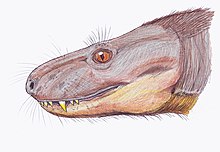| Moschowhaitsia Temporal range:
| |
|---|---|

| |
| Life restoration of Megawhaitsia vjuschkovi | |
| Scientific classification | |
| Domain: | Eukaryota |
| Kingdom: | Animalia |
| Phylum: | Chordata |
| Clade: | Synapsida |
| Clade: | Therapsida |
| Clade: | †Therocephalia |
| Family: | †Whaitsiidae |
| Genus: | †Moschowhaitsia Tatarinov, 1963 |
| Type species | |
| †Moschowhaitsia vjuschkovi Tatarinov, 1963
| |
| Other species | |
| |
Moschowhaitsia is an extinct genus of therocephalian therapsids from the Late Permian (Guadalupian) of Russia and China. The type species, Moschowhaitsia vjuschkovi, was discovered in the Changxingian-aged Archosaurus Assemblage Zone of Russia and named in 1963 by Russian palaeontologist Leonid Petrovich Tatarinov. A second species was discovered in Jingtai County of Gansu, China in 2020 and named as M. lidaqingi in 2023 by Jun Liu and Fernando Abdala, the first whaitsiid therocephalian to be discovered in China. It was among the larger carnivores in the faunal assemblages it occurred in, with a skull-length of up to 25 centimetres (9.8 in) in M. vjuschkovi and an even larger estimated 35 centimetres (14 in) for M. lidaqingi, one of the largest therocephalian skulls reported.[1][2] The genus name Moschowhaitsia alludes to two other therocephalians, Moschorhinus and Whaitsia (a junior synonym of Theriognathus), due to the structure of its palate combining physical features of both these genera.[3]
- ^ Bajdek, Piotr (2015). "Microbiota and food residues including possible evidence of pre-mammalian hair in Upper Permian coprolites from Russia". Lethaia. doi:10.1111/let.12156.
- ^ Liu, J.; Abdala, F. (2023). "Late Permian terrestrial faunal connections invigorated: the first whaitsioid therocephalian from China". Palaeontologia africana. 56: 16–35. hdl:10539/35706.
- ^ Tatarinov, L. P. (1963). "A new Late Permian therocephalian". Paleontological Journal. 4: 76–94.